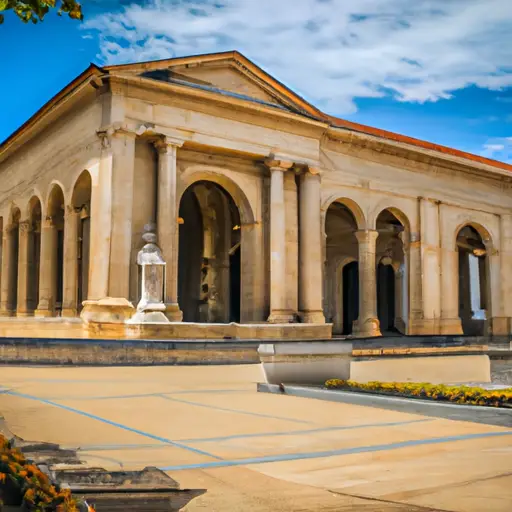Panteón Nacional – Santo Domingo : Interesting Facts, Information & Travel Guide

- By
- Aparna Patel
- |
- 28 Jun, 2023
- |

Welcome to a vivid exploration of the Panteón Nacional, a stunning mausoleum complex situated in Santo Domingo, the capital city of the Dominican Republic. As one of the most important monuments in this Caribbean nation, the Panteón Nacional offers a picturesque view of Dominican history and culture. Here, you’ll find plenty of interesting facts, insights, and even a few travel tips for making the most out of your visit to this incredible site. Discover how the Panteón Nacional has become the resting place of countless important figures in Dominican history and so much more as you explore this incredible article today!
Table of Contents
Interesting Facts About Panteón Nacional – Santo Domingo
1. The Panteón Nacional is the largest mausoleum in Latin America, featuring over 700 crypts and tombs, including those of notable political and cultural figures.
2. It was designed by architect Juan Angel Consuegra in neoclassical style and was opened in 1844.
3. The Panteón Nacional features two of the tallest statues in Santo Domingo, the Monument to the Heroes of the Restoration and the Monument to the Dead of the War of South Italy.
4. The Panteón Nacional was declared a Monument of Historical and Cultural Interest by royal decree in 1934.
5. It became part of UNESCO’s World Heritage Site in 1990.
6. There is a museum inside the Panteón Nacional which was opened in 1925 by President Horacio Vasquez.
7. Every year two weeks before Christmas, the Panteón Nacional holds a candlelight vigil called Las Velas De Corpus.
History & Information About Panteón Nacional – Santo Domingo
The Panteón Nacional (National Pantheon) is a cemetery located in the nation’s capital of Santo Domingo, Dominican Republic. It was established in 1852 and is the final resting place for many of the most important figures in Dominican history. Among its residents are the founding Fathers of Dominican independence, authors, musicians, poets, scientists, politicians, athletes and others. The cemetery is located on the grounds of the Old Palace of the Inquisition, and the building itself is considered a piece of architecture that has been preserved and declared a national monument.
The Panteón Nacional also serves as a cultural center and the site of various activities and events, such as religious observances. It has a large museum that includes exhibitions of documents, paintings, sculptures and artifacts related to the Dominican Republic’s history and culture. The museum also includes information about the cemetery’s residents, such as a list of their names, dates of death and biographies.
The Panteón Nacional is a significant place in the Dominican Republic and is among the most popular tourist attractions in the country. It is a symbolic representation of the national identity and culture of the Dominican people.
- Basílica Catedral Santa Cruz – La Vega : Interesting Facts, Information & Travel Guide
- Catedral Nuestra Señora del Carmen – La Romana : Interesting Facts, Information & Travel Guide
- Iglesia San Antonio de Padua – Jarabacoa : Interesting Facts, Information & Travel Guide
Travel Guide For Visiting Panteón Nacional – Santo Domingo
Visiting the Panteón Nacional – National Pantheon of Santo Domingo is an incredible way to pay tribute to the Dominican Republic’s most revered citizens for their contributions to the nation.
Getting There: The Panteón Nacional is located in the colonial center of Santo Domingo in the Dominican Republic, which is easily accessible via car, bus or taxi. The closest international airport is Las Américas International Airport and it is a 21 km drive (about 25 minutes) to the Pantheon.
Things to See and Do: The Pantheon is home to some of the most important people in the history of Santo Domingo. Among the memorials, you will find many figures from both religious and political backgrounds, like Juan Pablo Duarte, Francisco de Castro, Gregorio Luperón and President Juan Bosch. The Pantheon also has work from some of the Dominican Republic’s best artists, who created marble statues, paintings and stained glass.
Hours of Operation: The Pantheon opens daily from 9:00am to 3:00pm.
Admission: Admission is free year-round.
Other Tips: Please Note – To ensure the safety of the citizens inside the Pantheon, visitors are asked to obey the rules of the Pantheon. Visitors must remain quiet and respectful and must not enter any areas that are off-limits.
- Alcázar de Colón – Santo Domingo : Interesting Facts, Information & Travel Guide
- Catedral Santiago Apóstol – Santiago de los Caballeros : Interesting Facts, Information & Travel Guide
- Iglesia San Francisco – La Vega : Interesting Facts, Information & Travel Guide
Frequently Asked Questions About Panteón Nacional – Santo Domingo
Q1: Where is the Panteón Nacional located?
A1: The Panteón Nacional is located in Santo Domingo, Dominican Republic.
Q2: What is the purpose of the Panteón Nacional?
A2: The Panteón Nacional serves as a final resting place for the country’s heroes and historical figures. It also serves as a point of reference for Dominican patriotism, national identity, and pride.
Q3: Is the Panteón Nacional open to the public?
A3: Yes, the Panteón Nacional is open to the public and can be visited any day, except on Sundays.
Search Posts
Latest posts
-
4 Mar, 2024
Can I accidentally miss the in-flight food?
-
5 Mar, 2024
Passing through airport security with autism
-
4 Mar, 2024
Why would you wrap your luggage in plastic?
Popular posts
-
5 Mar, 2024
Why prohibit engine braking?